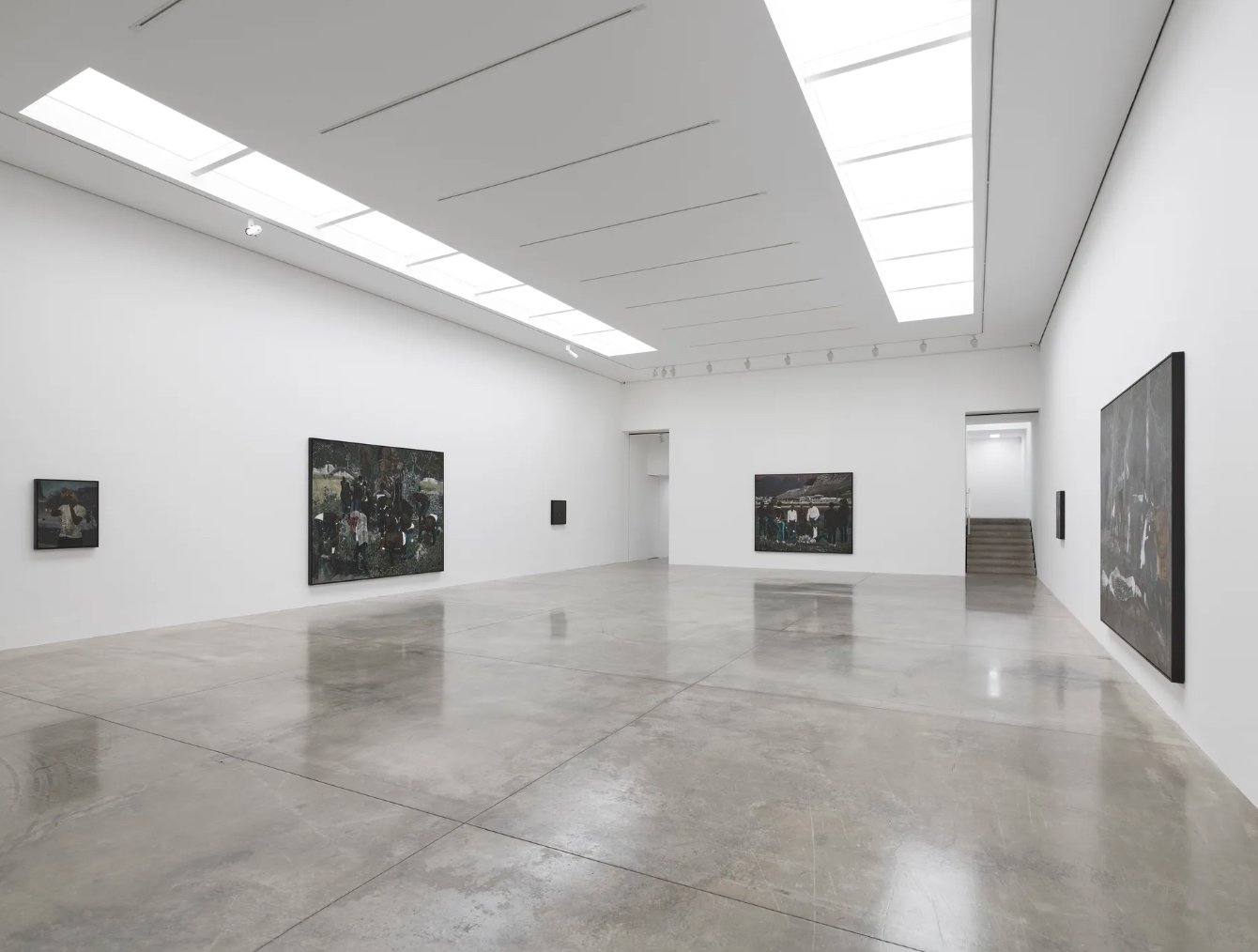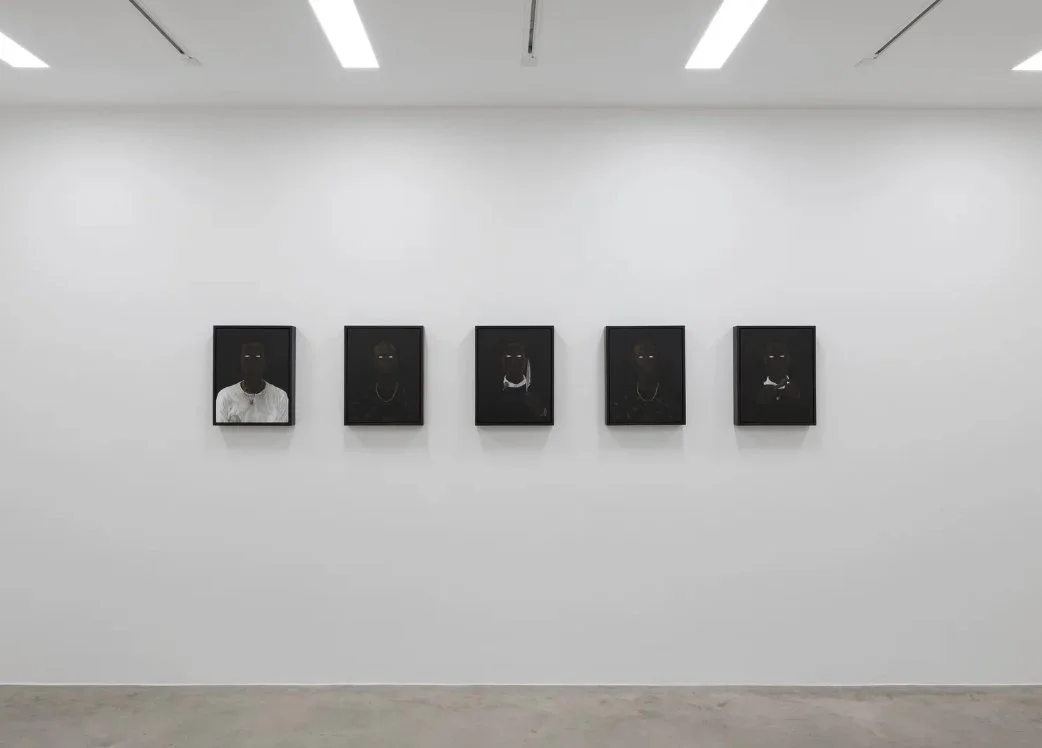Cinga Samson: Nzulu yemfihlakalo @ White Cube, Mason’s Yard
Situated within White Cube Mason’s Yard in St James’s, London, Samson’s first solo exhibition in the UK invites viewers into the world of the known and the unknown. With bold references towards his home, Cape Town, South Africa, this new body of oil paintings pays homage to the physicality of the area and the reverence of the spirit that inhabits both land and being. Confronting portraits coupled with large-scale ritualistic scenes place the viewer between the dizzying array of life and death, the familiar and unfamiliar.
Installation view. Cinga Samson: Nzulu yemfihlakalo. Image: White Cube.
These ideas are immediately recognisable in their reference within the exhibition’s title, Nzulu yemfihlakalo. Found in Xhosa and Zulu cultures, this term is used both as a devotion to and a description of God. Directly translated from amaXhosa, this phrase means ‘the depth of mystery’. Based on the works included in this exhibition, the linkage is easy to understand. The exhibition as a whole seems to be filled with mystery and juxtaposition.
This is done practically through the stark contrasts between the figure’s whitened eyes and the draperies common throughout the imagery against the toned-down palette of predominantly blues, blacks, and browns. With this meticulous attention to detail, rendering the images in a naturalistic style, viewers are confronted with depictions they can easily decipher. Simultaneously, they are consciously aware of the mysteriousness that forms a central theme throughout each work.
Isithozamo, 2023. Oil on canvas, 210 x 260cm. Image: Skylar Whittle.
This is explored further in Isithozamo (2023), whereby the viewer stumbles upon a group of figures busy within a body of water. All dressed in the same clothing with no distinguishable features, viewers are left wondering who these figures are and what their roles are within the narrative. Are they funeral workers or spirits? For viewers, this is another mystery.
While one does not know the exact location, enough visual detail is provided to calm the viewer’s potential hesitation when first confronted with the image; in the background appears to be a home with a lamp post and street sign, suggesting a residential area. Once this is secured, the eye travels towards the rest of the surroundings and begins to take in the shrubbery and work in which the figures are engaged.
Isithozamo, 2023. Detail. Image: Skylar Whittle.
Water becomes significant when looking at the natural influences that shape Samson’s body of work. In many traditional African cultures, water is seen as a purifier and a source of life. Again, juxtaposition comes into play when the body of water is contrasted with the drapery cloth that features prominently within the image and alludes to the notion of a religious or spiritual burial. While there is nothing to confirm nor deny this assumption, there seems to be a revered silence within the image. Noticeably all the figures, except for one on the left of the image, do not acknowledge the viewer, so engrossed they are in their ceremony. The figure that appears to notice the viewer stares straight ahead, catching the audience’s eye with his vacant stare. With no discernable expression, one questions whether they have stumbled upon an intimate ceremony they should not be a part of or are quietly invited to watch and observe from a distance.
Another aspect that stands out within Samson’s larger works is the balance he achieved between the figures and the spaces they occupy. Whether this is by chance through his colour choice or strategically planned during the preparation period, there is a noticeable harmony between the materiality of the body and nature. This again alludes towards traditional African beliefs, whereby the role of man and nature are interconnected. Used as a form of communication with ancestors, the importance of land in African history, culture, and traditions is intensified.
uDondolo, 2023. Oil on canvas, 50 x 60cm. Image: White Cube.
This is particularly true of South African history, where, during the Apartheid regime, millions were displaced. uDondolo (2023) solemnly references this treacherous history. The image depicts the emblem for Cape Town, Table Mountain. Captured as an aerial shot, viewers are faced with the city and some of its most well-known destinations, such as Signal Hill and Lion’s Head. To the left of the image, these include the city centre, with the Atlantic Ocean in the background.
Paired with Samson’s shadowy palette, the image contrasts with the usual vibrant greens and blues synonymous with standard images of Cape Town. It alludes to not only the darker history of the surrounding area’s geography but could perhaps also hint at the interconnectedness between manmade structures of the city and natural resources, such as the mountain, ocean, and the characteristic flora and fauna found within Cape Town.
Installation view. Cinga Samson: Nzulu yemfihlakalo. Image: White Cube.
While dichotomy proves to be a central theme throughout the body of work, this aspect could also be extended towards the technique these images are done in, specifically relating to the link between light and dark. With the subject matter centred around the relationship between the known and unknown, the conscious and subconscious, and the physical and spiritual, the stark whites of material and greens of nature seem to refer to the former. At the same time, the shadows, figures, and surrounding areas appear to speak to the latter. When viewed as a whole, each piece starts to relate towards the title of the exhibition and the mystery that viewers are still left with after a lap around the gallery.
Ukuphicothwa Kwento Xa Ingaziwa, 2023. Oil on canvas, 220 x 260cm. Image: Skylar Whittle.
Overall, Samson has provided audiences with a commendable body of work that speaks to the soul and spirit of the human being. A strong theoretical background, detailed technical skill, and the sheer size of some works place the viewer within the physical space presented in these pictures and beyond. As the exhibition’s title suggests, coupled with specific subject matters relating to burial and ceremony, one is invited to internally reflect on what Samson offers in his art. But more than this, by exploring the notions of geography, nature, religion, and spirituality, Samson places the viewer right at the intersection of past, present, and future from both a universal and individual perspective.
Cinga Samson: Nzulu yemfihlakalo is on show at White Cube, Mason’s Yard until 26 August 2023.
Skylar Whittle
Contributing Writer, MADE IN BED







